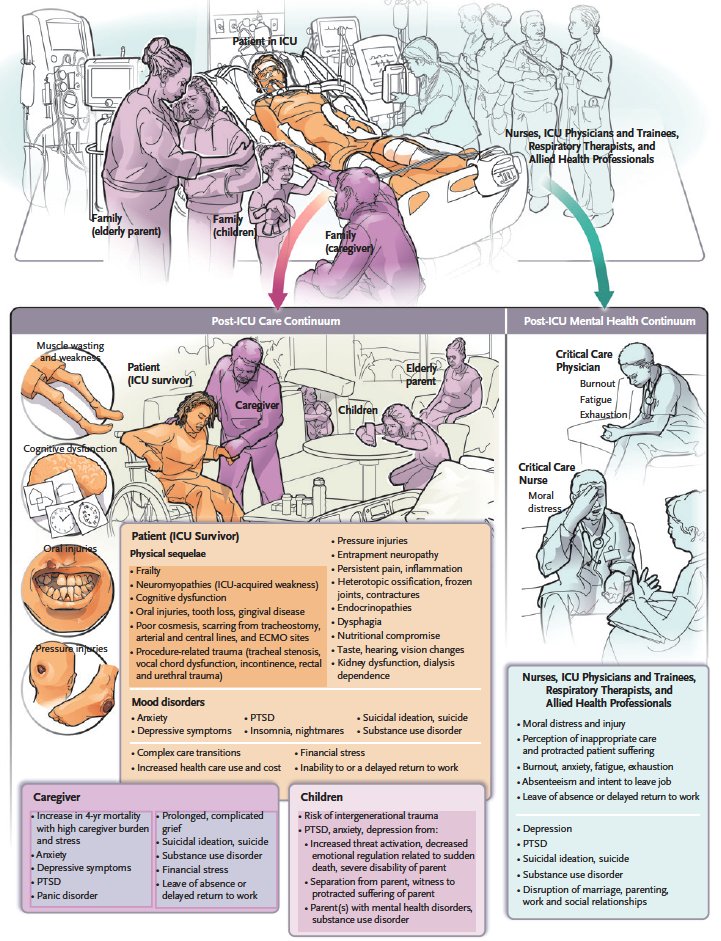Metastatic #ColorectalCancer is treated with fluorouracil-based combination chemotherapy with oxaliplatin, with or without irinotecan.
Read the Science behind the Study: nej.md/3VnWj8L 1/15
Read the Science behind the Study: nej.md/3VnWj8L 1/15
Inhibitors of vascular endothelial growth factor (VEGF), such as bevacizumab, or epidermal growth factor receptor (EGFR) (for patients without activating RAS variants) are sometimes also included. 2/15 

Patients with treatment-refractory disease who have progression after these therapies have limited treatment options, outside of clinical trials. 3/15
In NEJM, Prager et al. evaluated a combination therapy — trifluridine–tipiracil and bevacizumab — in a randomized phase 3 trial involving patients with refractory metastatic colorectal cancer.
Full trial results: nej.md/3HxuhBV 4/15
Full trial results: nej.md/3HxuhBV 4/15
They found that median overall survival was longer by 3.3 months and median progression-free survival was longer by 3.2 months among patients who received the combination therapy than among those who received trifluridine–tipiracil only. 5/15
Trifluridine is an orally bioavailable thymidine-based nucleoside analogue. Like other fluoropyrimidines, trifluridine is phosphorylated by thymidylate kinase to produce trifluridine mono & triphosphate derivatives, both of which inhibit the proliferation of tumor cells. 6/15 

Trifluridine monophosphate irreversibly inhibits thymidylate synthase, and trifluridine triphosphate is incorporated into DNA in place of TTP; once incorporated, it damages DNA, causing cell death. 7/15
Research by Heidelberger and contemporaries in the 1960s and 1970s showed that orally administered trifluridine is rapidly metabolized in the gastrointestinal system and liver by thymidine phosphorylase, leading to a lack of efficacy. 8/15
Tipiracil, an inhibitor of thymidine phosphorylase, prevents the metabolism of trifluridine, leading to its increased bioavailability. A fixed-dose combination of trifluridine + tipiracil is approved for use in patients with metastatic colorectal cancer in the U.S. 9/15
Bevacizumab is a humanized monoclonal antibody that neutralizes VEGF, a cytokine secreted by multiple different types of cells in the body that has roles in development, hematopoiesis, and wound healing. 10/15 

Secretion of VEGF by tumor cells and tumor-associated macrophages leads to neoangiogenesis, proliferation, and metastasis through the effects of VEGF on endothelial cells. 11/15
The dependency of some tumors on angiogenesis and the hypothesis that antiangiogenic agents would suppress tumor cells were described in NEJM more than 50 years ago. Read the article: nej.md/3nrKWQv 12/15
Bevacizumab was approved for the treatment of colorectal cancer in 2004. Given the apparently independent mechanisms of trifluridine–tipiracil and bevacizumab, the combination of both agents would be hypothesized to have additive, if not synergistic, effects. 13/15
Trifluridine–tipiracil improves overall survival among patients with refractory metastatic colorectal cancer, and its efficacy, when combined with bevacizumab, has been tested in phase 1–2 trials of treatment-refractory metastatic colorectal cancer. 14/15
Read “Combination Therapy, Including Bevacizumab, for Advanced Colorectal Cancer” by Oladapo O. Yeku, M.D., Ph.D., and Dan L. Longo, M.D.: nej.md/3VnWj8L 15/15
• • •
Missing some Tweet in this thread? You can try to
force a refresh

 Read on Twitter
Read on Twitter







